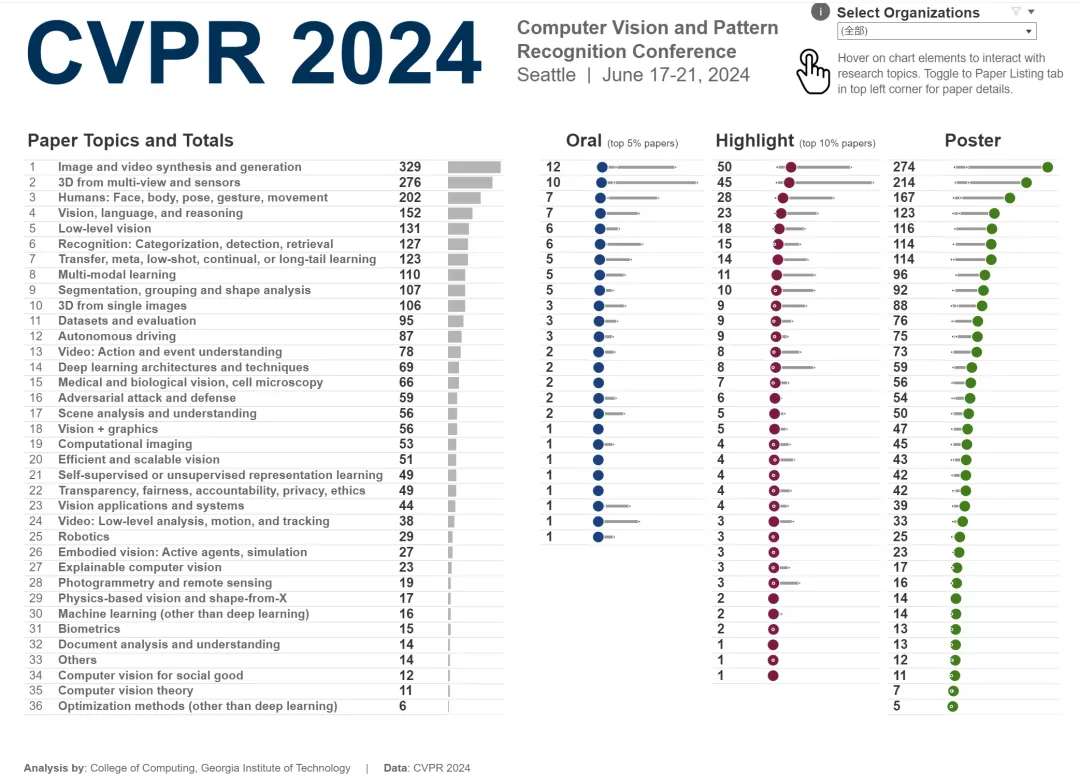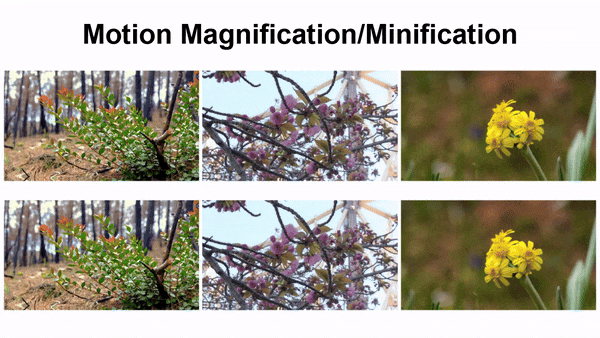
In the early morning of June 20th, Beijing time, CVPR 2024, the top international computer vision conference held in Seattle, officially announced the best paper and other awards.
A total of 10 papers won awards this year, including 2 best papers, 2 best student papers, in addition to 2 best paper nominations and 4 best student paper nominations.

The top conference in the field of computer vision (CV) is CVPR, which attracts a large number of research institutions and universities to participate every year. According to statistics, a total of 11,532 papers were submitted this year, 2,719 of which were accepted, with an acceptance rate of 23.6%.
According to Georgia Institute of Technology’s statistical analysis of CVPR 2024 data, in terms of research topics, the largest number of papers is the topic of Image and video synthesis and generation, with a total of 329 papers.

The total number of participants this year is higher than in previous years, and more and more people choose to participate offline.

Best Paper
Paper 1: Generative Image Dynamics
Authors: Zhengqi Li, Richard Tucker, Noah Snavely, Aleksander Holynski
Institution: Google Research
Paper address: https://arxiv.org/pdf/2309.07906

Zhengqi Li is a research scientist at Google DeepMind. Previously, he received his PhD in Computer Science from Cornell University, where he studied under Professor Noah Snavely. His research has received several awards, including the 2020 Google PhD Fellowship, the 2020 Adobe Research Fellowship, CVPR 2019 and CVPR 2023 Best Paper Honors, and ICCV 2023 Best Student Paper Award.
Abstract: This study proposes an image-space prior method for modeling scene motion. The prior is learned from a collection of motion trajectories extracted from real video sequences, depicting the natural oscillation dynamics of objects such as trees, clothing, etc. swaying in the wind. The study models dense long-term motion in the Fourier domain as a spectral volume, which the team found is well suited to prediction with diffusion models.

Given a single image, the model trained in this study uses a frequency-coordinated diffusion sampling process to predict the spectral volume, which can also be converted into a motion texture that spans the entire video.运动 This study can reduce (top) or zoom (bottom) animation motion by adjusting the amplitude of the motion texture.

Paper 2: Rich Human Feedback for Text-to-Image Generation

From the author column of the paper, we can It can be seen that many Chinese participated in this research. Among them, Youwei Liang is a doctoral student in the Department of Electrical and Computer Engineering at the University of California, San Diego. Before that, he was an undergraduate student majoring in information and computer science at South China Agricultural University; Junfeng He comes from Google. He previously graduated with a master's degree from Tsinghua University.
Abstract: Recently, text-to-image (T2I) generative models have made significant progress, capable of generating high-resolution images from text descriptions. However, many generated images still suffer from artifacts/untrustworthy, factual inconsistency, and poor aesthetics.
Inspired by the successful use of reinforcement learning with human feedback (RLHF) for large language models, this research enriches the feedback signal by:
marking untrustworthy or misaligned image areas with text;
pairs Annotate situations where words in the text prompt are distorted or missing on the image.

This study created the 18K generated image dataset RichHF-18K, collected rich human feedback on RichHF-18K, and trained a multi-modal transformer to automatically predict feedback. The study demonstrates that predicted human feedback can be used to improve image generation, such as by selecting high-quality training data to fine-tune and improve generative models, or by creating masks to repair problematic image areas.

Best Paper Runner-up
Paper 1: EventPS: Real-Time Photometric Stereo Using an Event Camera
Authors: Bohan Yu, Jieji Ren, Jin Han, Feishi Wang, Jinxiu Liang, Boxin Shi
Institutions: Peking University, Shanghai Jiao Tong University, etc.
Paper address: https://openaccess.thecvf.com/content/CVPR2024/papers/Yu_EventPS_Real-Time_Photometric_Stereo_Using_an_Event_Camera_CVPR_2024_paper.pdf

Paper 2: pixelSplat: 3D Gaussian Splats from Image Pairs for Scalable Generalizable 3D Reconstruction
Authors: David Charatan, Sizhe Lester Li, Andrea Tagliasacchi, Vincent Sitzmann
Institution: MIT, Simon Fraser University, Toronto University
Paper address: https://openaccess.thecvf.com/content/CVPR2024/papers/Charatan_pixelSplat_3D_Gaussian_Splats_from_Image_Pairs_for_Scalable_Generalizable_CVPR_2024_paper.pdf

Best Student Paper
Paper 1: BioCLIP: A Vision Foundation Model for the Tree of Life
Authors: Samuel Stevens , Jiaman Wu , Matthew J Thompson , Elizabeth G Campolongo , Chan Hee Song , David Edward Carlyn , Li Dong , Wasila M Dahdul , Charles Stewart , Tanya Berger-Wolf , Wei-Lun Chao, Yu Su
Institution: Ohio State University, Microsoft Research, University of California, Irvine, Rensselaer Polytechnic Institute
Paper address: https://arxiv.org/pdf/2311.18803
Abstract: Images of the natural world collected by cameras ranging from drones to personal cell phones are increasingly becoming a rich source of biological information. There is an explosion of computational methods and tools, especially computer vision, for extracting biologically relevant information from scientific and conservation images. However, most of them are customized methods designed for specific tasks and are not easily adapted or extended to new problems, contexts, and data sets. Researchers urgently need a visual model for general biological problems of organisms on images.
To achieve this goal, the research curated and released TREEOFLIFE-10M, the largest and most diverse ML-ready biological image dataset. Based on this, the researchers developed the basic model BIOCLIP, which is mainly used to construct the tree of life (tree of life), using the unique attributes of biology captured by TREEOFLIFE-10M, that is, the richness and diversity of images of plants, animals and fungi, and rich knowledge of structured biology. Tree diagram of 108 gates in TREEOFLIFE-10M.

Intrinsic evaluation shows that BIOCLIP has learned a hierarchical representation consistent with the Tree of Life, revealing its strong generality.
Paper 2: Mip-Splatting: Alias-free 3D Gaussian SplattingPaper authors: Zehao Yu, Anpei Chen, Binbin Huang, Torsten Sattler, Andreas GeigerInstitutions: University of Tübingen, Tübingen Artificial Intelligence Center, Shanghai University of Science and Technology, Breitning, Czech Technical University in Prague
Paper address: https://arxiv.org/abs/2311.16493

Abstract: Recently, 3D Gaussian splattering techniques have demonstrated impressive results in novel view synthesis, reaching high fidelity and efficiency levels. However, when changing the sampling rate (for example by changing the focal length or camera distance), strong artifacts may appear.

3D Gaussian splatter works by representing a 3D object as a 3D Gaussian function that is projected onto the image plane, followed by a 2D dilation in screen space, as shown in Figure (a). The inherent shrinkage bias of this method causes the degenerate 3D Gaussian function to exceed the sampling limit, as shown by the δ function in Figure (b), while it renders similar to 2D due to the dilation operation. However, when changing the sampling rate (either via focal length or camera distance), strong dilation effects (c) and high-frequency artifacts (d) are observed.
The research team found that the reason for this phenomenon can be attributed to the lack of 3D frequency constraints and the use of a 2D dilation filter. To solve this problem, they introduced a 3D smoothing filter that constrains the size of 3D Gaussian primitives according to the maximum sampling frequency induced by the input view, thereby eliminating high-frequency artifacts when zooming in.
In addition, the author team replaced the 2D dilation filter with a 2D Mip filter, which simulates the 2D box filter and effectively alleviates the aliasing and expansion problems. The researchers verified the effectiveness of this method based on evaluations, including scenarios such as training on single-scale images and multi-scale testing.
Runner-up for Best Student Paper
Paper: SpiderMatch: 3D Shape Matching with Global Optimality and Geometric Consistency
Author: Paul Roetzer, Florian Bernard
Institution: University of Bonn
Link : https://openaccess.thecvf.com/content/CVPR2024/papers/Roetzer_SpiderMatch_3D_Shape_Matching_with_Global_Optimality_and_Geometric_Consistency_CVPR_2024_paper.pdf

Paper: Image Processing GNN: Breaking Rigidity in Super-Resolution
Author: Yuchuan Tian, Hanting Chen, Chao Xu, Yunhe Wang
Institution: Peking University, Huawei Noah's Ark Laboratory
Link: https://openaccess.thecvf.com/content/CVPR2024/papers/Tian_Image_Processing_GNN_Breaking_Rigidity_in_Super-Resolution_CVPR_2024_paper.pdf

Paper: Objects as volumes: A stochastic geometry view of opaque solids
Authors: Bailey Miller, Hanyu Chen, Alice Lai, Ioannis Gkioulekas
Institution: Carnegie Mellon University
Link: https://arxiv.org/pdf/2312.15406v2

Paper: Comparing the Decision-Making Mechanisms by Transformers and CNNs via Explanation Methods
Author: Mingqi Jiang , Saeed Khorram, Li Fuxin
Institution: Oregon State University
Link: https://openaccess.thecvf.com/content/CVPR2024/papers/Jiang_Comparing_the_Decision-Making_Mechanisms_by_Transformers_and_CNNs_via_Explanation_CVPR_2024_paper .pdf

Others Awards
The conference also announced the PAMI TC awards, including the Longuet-Higgins Award, Young Investigator Award, and Thomas S. Huang Memorial Award.

Longuet-Higgins Award
The Longuet-Higgins Award is the "Computer Vision Fundamental Contribution Award" awarded by the IEEE Computer Society Pattern Analysis and Machine Intelligence (PAMI) Technical Committee at the annual CVPR to recognize the contributions to computer vision ten years ago. CVPR papers that have had a significant impact on computer vision research. The award is named for theoretical chemist and cognitive scientist H. Christopher Longuet-Higgins.
This year’s award-winning paper is "Rich Feature Hierarchies for Accurate Object Detection and Semantic Segmentation".

Authors: Ross Girshick, Jeff Donahue, Trevor Darrell and Jitendra Malik
Institution: UC Berkeley
Paper link: https://arxiv.org/abs/1311.2524
Young Researcher Awards
The Young Researcher Awards aim to recognize young scientists and encourage them to continue to make groundbreaking work. The criteria for selection is that the recipient has had less than 7 years of experience earning his or her PhD.
This year’s winners are Angjoo Kanazawa (UC Berkeley) and Carl Vondrick (Columbia University).

Also, Katie Bouman (Caltech) received an honorable mention for the Young Investigator Award.

Thomas Huang Memorial Award
At CVPR 2020, in memory of Professor Thomas S. Huang (Huang Xutao), the PAMITC Awards Committee approved the establishment of the Thomas S. Huang Memorial Award in recognition of CV research, education and service Researchers who are recognized as role models. The award will be awarded starting in 2021. Recipients need to have held their PhD for at least 7 years, preferably in mid-career (no more than 25 years).
This year’s winner is Oxford University professor Andrea Vedaldi.

For more information, please refer to: https://media.eventhosts.cc/Conferences/CVPR2024/OpeningRemarkSlides.pdf
Reference link:
https://public.tableau.com /views/CVPR2024/CVPRtrends?%3AshowVizHome=no&continueFlag=6a947f6367e90acd982f7ee49a495fe2
The above is the detailed content of All CVPR 2024 awards announced! Nearly 10,000 people attended the conference offline, and a Chinese researcher from Google won the best paper award. For more information, please follow other related articles on the PHP Chinese website!